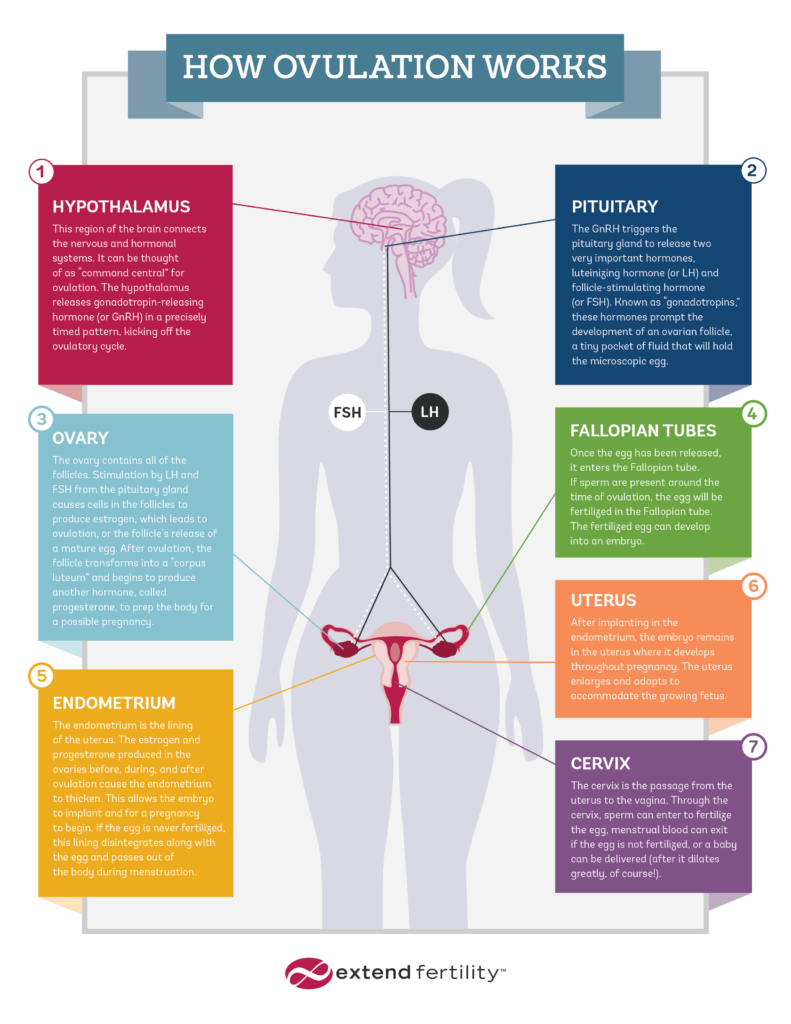Sure, you get a period every month, or every few weeks, or every few months, or maybe irregularly (every body is different!). But there’s a lot you might not know about what’s going inside your body that gets your eggs from point A to point B. Get out your notebooks and let’s review—don’t worry, we won’t be quizzing you when we’re done.
The ovulation cycle begins in the brain.
No, we don’t mean that rollercoaster of emotions you start to ride just before “that time of the month.” We’re referring to the hypothalamus, a region of the brain that connects the nervous and endocrine systems and releases the hormone (gonadotropin-releasing hormone) that kicks off the ovulatory cycle. That hormone then triggers the pituitary gland, also in the brain, to produce other hormones (luteinizing hormone and follicle-stimulating hormone), which stimulate your ovaries to produce still other hormones (estrogen and progesterone) that prompt ovulation. Yes, your body is like a never-ending Rube Goldberg machine.

Your ovaries take turns, but they don’t play fair.
Most women have two ovaries, one on the right and one on the left. During the first week or so after your period begins, both ovaries are hard at work growing follicles that could become mature eggs. However, around day 7, one egg becomes the dominant egg—let’s call her the Queen Egg—and the other follicles in both ovaries take a load off, eventually degenerating. (These otherwise “lost” eggs are the ones that are matured, retrieved, and preserved during egg freezing!) The Queen Egg continues to grow in preparation for her release around day 14.
Each month, only one ovary develops a Queen Egg. (Typically, that is. The presence of multiple Queen Eggs could mean the release of both during ovulation—resulting in the possibility of a fraternal twin pregnancy if both are fertilized!) But which ovary develops the Queen isn’t a simple left-right-left-right alternation, nor is it purely random. Multiple studies (1, 2, 3) have demonstrated that, likely due to anatomical differences between the right and left sides of the reproductive system, the right ovary is significantly more likely to serve as the palace for your Queen Egg.
PMS isn’t the only side effect of your cycle.
PMS, or premenstrual syndrome, refers to the collection of symptoms like headaches, cramps, mood swings, and food cravings that many women experience just before or during their period. However, about two weeks before PMS makes its visit, some women experience different symptoms—those associated with ovulation. One example is “mittelschmerz,” a funny-sounding name for pain felt on one side of the abdomen, the side that’s releasing the Queen Egg, during ovulation. The word is German for middle (mittel) pain (schmerz), or pain felt at the middle of your cycle.
But the side effects of ovulation aren’t all bad. Studies show that during ovulation, women smell better to potential partners (especially men) and become more flirtatious.
The Fallopian tubes are more than a simple passage from ovaries to uterus.
The Fallopian tubes, which connect to the uterus at the top, are typically thought of as the “hallways” from the ovaries to the uterus—an egg, once released, is pulled in by the finger-like appendages at the end of the Fallopian tube, through which it travels down into the uterus over a period of 12–24 hours. However, in the case of unprotected sex around the time of ovulation, the Fallopian tube rises to its higher purpose: it becomes the venue for fertilization.
Sperm actually have a surprisingly long journey toward the egg. After entering through the vagina, they have to make it through the cervix, across the uterus, and into the Fallopian tubes where the egg is waiting. They have a really good chance of dying or getting trapped or lost (perhaps up the wrong Fallopian tube), and of the millions of sperm that start this journey, only a dozen or so—the strongest swimmers—actually make it all the way. The good news (for the sperm, at least), is that they can survive stealthily inside the reproductive system for several days, so it’s possible to get pregnant even if you have unprotected sex before you ovulate.
And if that egg isn’t fertilized? Find out next week, when we explore everything you’ve ever wanted to know about your period.
Okay, that’s all for today. Class dismissed!




